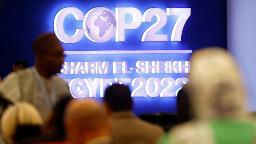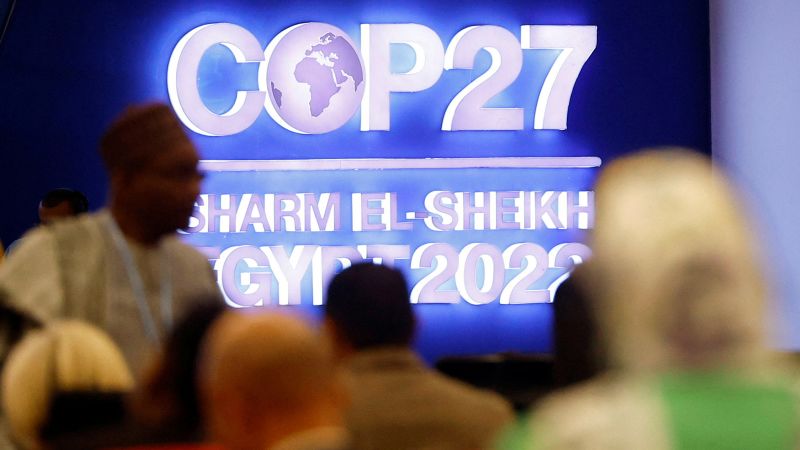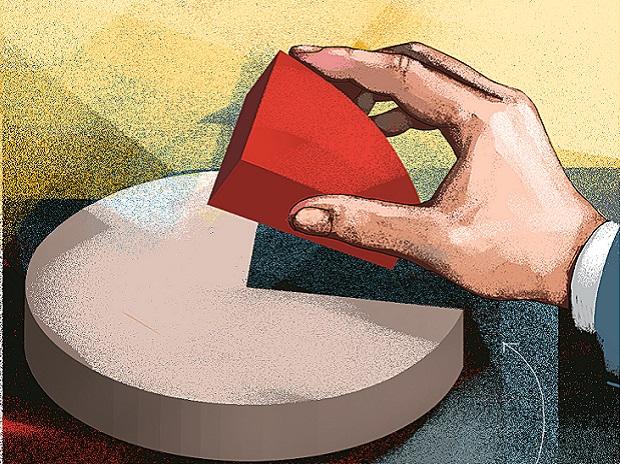
Sharm el-Sheikh, Egypt
CNN
—
Negotiators at the UN’s COP27 climate summit have reached a tentative agreement to establish a loss and damage fund for nations vulnerable to climate disasters, according to negotiators with the European Union and Africa, as well as non-governmental organizations who are observing the talks.
The United States is also working to sign on to a deal on a loss and damage fund, Whitney Smith, a spokesperson for US Climate Envoy John Kerry, confirmed to CNN.
The fund will focus on what can be done to support loss and damage resources, but it does not include liability or compensation provisions, a senior Biden administration official told CNN. The US and other developed nations have long sought to avoid such provisions that could open them up to legal liability and lawsuits from other countries.
If finalized, this could represent a major breakthrough in negotiations on a contentious subject – and it’s seen as a reversal, as the US has in the past opposed efforts to create such a fund. It could pave the way for an agreement at a final Sharm el-Sheikh COP27 plenary expected come on Saturday night Egypt time.
But it’s not yet settled – an EU source directly involved with the negotiations cautioned earlier Saturday that the deal is part of the larger COP27 agreement that has to be approved by nearly 200 countries. Negotiators have been working throughout the day and into the night.
But progress has been made, the source said. In a discussion Saturday afternoon Egypt time, the EU managed to get the G77 bloc of countries to agree to target the fund to vulnerable nations, which could pave the way to a deal on loss and damage.
If finalized, the deal would represent a major breakthrough on the international stage and far exceed the expectations of this year’s climate summit, and the mood among some of the delegates was jubilant.
Countries who are the most vulnerable to climate disasters – yet who have contributed little to the climate crisis – have struggled for years to secure a loss and damage fund.
Developed nations that have historically produced the most planet-warming emissions have been hesitant to sign off on a fund they felt could open them up to legal liability for climate disasters.
Details on how the fund would operate remain murky. The tentative text says a fund will be established this year, but it leaves a lot of questions on when it will be finalized and become operational, climate experts told reporters Saturday. The text talks about a transitional committee that will help nail down those details, but doesn’t set future deadlines.
“There are no guarantees to the timeline,” Nisha Krishnan resilience director for World Resources Institute Africa told reporters.
Advocates for a loss and damage fund were happy with the progress, but noted that the draft is not ideal.
“We are happy with this outcome because it’s what developed countries wanted – though not everything they came here for,” Erin Roberts, founder of the Loss and Damage Collaboration, told CNN in a statement. “Like many, I’ve also been conditioned to expect very little from this process. While establishing the fund is certainly a win for developing countries and those on the frontlines of climate change, it’s an empty shell without finance. It’s far too little, far too late for those on the frontlines of climate change. But we will work on it.”
At COP27 the demand for a loss and damage fund – from developing countries, the G77 bloc and activists – had reached a fever pitch, driven by a number of major climate disasters this year including Pakistan’s devastating floods.
The conference went way into overtime on Saturday, with negotiators still working out the details as the workers were dismantling the venue around them. At points, there was a real sense of fatigue and frustration.
Earlier in the day, EU officials threatened to walk out of the meeting if the final agreement fails to endorse the goal to limit warming to 1.5 degrees Celsius above pre-industrial levels.
Global scientists have for decades warned that warming must be limited to 1.5 degrees – a threshold that is fast-approaching as the planet’s average temperature has already climbed to around 1.1 degrees. Beyond 1.5 degrees, the risk of extreme drought, wildfires, floods and food shortages will increase dramatically, scientists said in the latest UN Intergovernmental Panel on Climate Change (IPCC) report.
In a carefully choreographed news conference Saturday morning, the EU’s Green Deal tsar Frans Timmermans, flanked by a full line-up of ministers and other top officials from EU member states, said that “no deal is better than a bad deal.”
“We do not want 1.5 Celsius to die here and today. That to us is completely unacceptable,” he said.
The EU made it clear that it was willing to agree to a loss and damage fund – a major shift in its position compared to just a week ago – but only in exchange for a strong commitment on the 1.5 degree goal.
The US, meanwhile, remained largely invisible on Saturday, with its main player, US climate envoy John Kerry, self-isolating with Covid-19.
As the sun went down on Sharm el-Sheikh, the mood shifted to cautious jubilation, with groups of negotiators starting to hint that a deal was in sight.
But, as is always the case with top-level diplomacy, officials were quick to stress that nothing is truly agreed until the final gavel drops.
Note:- (Not all news on the site expresses the point of view of the site, but we transmit this news automatically and translate it through programmatic technology on the site and not from a human editor. The content is auto-generated from a syndicated feed.))




I was suggested this web site by my cousin. I am not sure whether this post is written by him as no one else
know such detailed about my problem. You are incredible!
Thanks!
my blog you can try this out
penis enlargement
Pretty great post. I just stumbled upon your blog and wanted to mention that I have really enjoyed surfing around your weblog posts.
After all I will be subscribing to your rss feed and I’m hoping you write again very soon!
Take a look at my homepage รับจัดงานแต่งงาน
You are so cool! I do not think I’ve truly read through
something like this before. So wonderful to discover somebody with unique thoughts on this subject.
Seriously.. thanks for starting this up. This website is one thing that is needed on the web, someone with some
originality!
I like the helpful information you provide on your articles.
I’ll bookmark your blog and check again here frequently.
I am relatively certain I’ll be told many new stuff proper right here!
Best of luck for the following!
Undeniably believe that that you stated. Your favorite reason appeared to be
on the web the simplest thing to understand of.
I say to you, I definitely get irked at the same time as other folks consider issues that they just don’t recognize about.
You managed to hit the nail upon the top and defined out
the whole thing with no need side effect , other people could take a signal.
Will probably be back to get more. Thanks
Also visit my web-site – ผลหวยดาวโจนส์ ruay